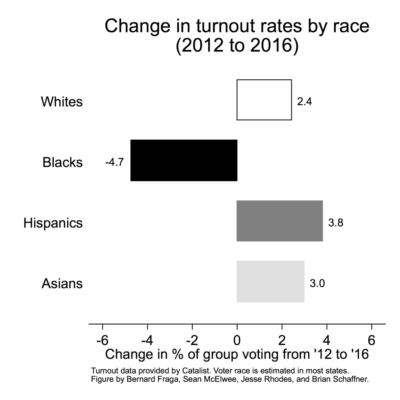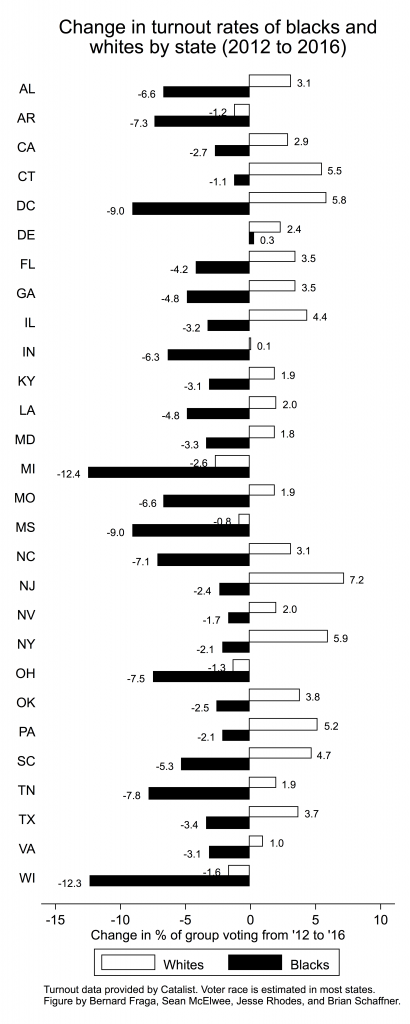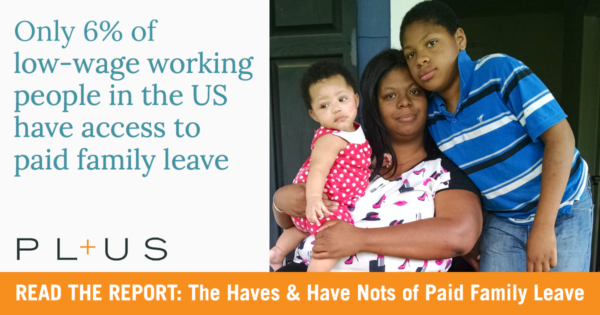The Haves and Have Notes of Paid Family Leave
Paid Leave for the United States (PL+US) has a new report that looks at the different paid parental leave offered to corporate vs frontline employees at some of the country’s largest companies – and the impact that inequity has on low-income families.
In the United States today, paid family leave is an elite benefit: 94% of low-income working people have no access to paid family leave. Millions of Americans don’t get even a single day of paid time for caregiving. 1 in 4 new moms in the U.S. is back at work just ten days after childbirth. While public discourse often focuses on income inequality, there is another critical way families experience inequality: the inability to be with their babies and families for the most important moments of their lives.
Read the PL+US report’s findings and their index of the top retailers leading the way — and the major corporate employers that are lagging behind.
Why did Trump win? More whites — and fewer blacks — actually voted.
Check out this deep dive from four Washington Post reporters:
“Using data from the voter file vendor Catalist and information from the U.S. Census Bureau, we examine the change in turnout rates for different racial/ethnic groups between 2012 and 2016. Black turnout declined dramatically; white turnout increased noticeably; and Latino and Asian American turnout went up even more. In the key swing states of Michigan, Wisconsin, and Pennsylvania, those shifts were especially strong. How strong? Without those shifts in turnout from various racial and ethnic groups, these pivotal states might have gone not to Trump but to Clinton — giving Clinton an electoral college victory.”
Two graphics in their piece show the stark difference in turnout:


“As you can see, the national average hides dramatic differences among states. For example, as we’ve said, the African American turnout rate fell by 4.7 points nationally. But in Michigan and Wisconsin — two key Midwestern states where, to analysts’ surprise, Trump won — black turnout fell by more than 12 points.
Similarly, overall white turnout increased by only 2.5 points nationally. But in several states it surged by more than 5 points. In the critical battleground state of Florida, white voter turnout jumped by 4 points — and black turnout fell by 4 points. Trump won Florida by a margin of just 1.2 points.”
So, in the end, what impact did decreased / depressed turnout of Black voters have on the election?
“If we changed nothing but the turnout rates of various racial and ethnic groups, in Michigan, the actual Clinton loss by .2 percentage points would have become a victory by 1.5 percentage points. Clinton’s actual loss by 0.7 percentage points in Pennsylvania would have been a 0.5 percent victory. And instead of Trump winning Wisconsin by 0.8 points, Clinton would have won by 0.1 percent. Clinton’s electoral college total would have been 278 votes, putting her in the White House.”
“Of course, these measures are estimates and subject to error. Interpret cautiously. But what’s clear is that the jump in white turnout in key swing states and drop in black turnout may well have handed the presidency to Trump.”
Wisconsin’s Voter-ID Law Suppressed 200k Votes in 2016 (Trump Won by 22,748)
Ari Berman writes in The Nation:
A new study by Priorities USA, shared exclusively with The Nation, shows that strict voter-ID laws, in Wisconsin and other states, led to a significant reduction in voter turnout in 2016, with a disproportionate impact on African-American and Democratic-leaning voters. Wisconsin’s voter-ID law reduced turnout by 200,000 votes, according to the new analysis. Donald Trump won the state by only 22,748 votes.
The study compared turnout in states that adopted strict voter-ID laws between 2012 and 2016, like Wisconsin, to states that did not.”
“While states with no change to voter identification laws witnessed an average increased turnout of +1.3% from 2012 to 2016, Wisconsin’s turnout (where voter ID laws changed to strict) dropped by -3.3%. If turnout had instead increased by the national- no-change average, we estimate that over 200,000 more voters would have voted in Wisconsin in 2016.”
Read the full story at The Nation.
The Middle Class Is Shrinking, And It's Becoming More Female
The United States Census Bureau’s new report, “The Changing Economics and Demographics of Young Adulthood: 1975–2016,” reveals how much being a grown up has changed over the past forty years. “Marrying and having children,” the report states, are not seen as “very important.” Instead, young people prioritize “educational and economic accomplishments.”
A CNBC analysis confirms that “it’s not just ideas that are changing, though. The middle class is shifting altogether. It’s not just getting smaller; it’s also becoming more female.”
The report contains a bit of good news for young women:
“The report states that “young women have made considerable economic gains … The share of young women who earned $60,000 or more grew from about two percent to 13 percent — a minority, but still a sizable change.” Though in part because the men at the top still make so much more, young women’s median incomes remain “$11,000 lower than the income of young men.”
However, “women of all ages still hold many fewer of the most highly paid jobs. According to BLS data, there are a handful of jobs in which women make at least $1,300 a week, but as CNBC reported this year in honor of Equal Pay Day, “In the most lucrative professions, women make up less than 30 percent in each role.”
Read the Census Bureau’s full report at Census.gov.
IWPR: #EqualPay Cuts Poverty Rate In Half for Children with a Working Mother
The Institute for Women’s Policy Research recently published a new report on The Impact of Equal Pay on Poverty and the Economy. This in-depth study explores the economic benefits that equal pay would offer families with a working mother – as well as the harsh realities that Americans currently face due to the wage gap.
Top findings include:
- Nearly 60 percent of women would earn more if working women were paid the same as men of the same age with similar education and hours of work. Nearly two-thirds (65.9 percent) of working single mothers would receive a pay increase.
- Providing equal pay to women would have a dramatic impact on their families. The poverty rate for all working women would be cut in half, falling from 8.0 percent to 3.8 percent. The very high poverty rate for working single mothers would fall by nearly half, from 28.9 percent to 14.5 percent.
- For the 15.3 million single women—divorced, widowed, separated, and never married women living on their own—equal pay would mean a significant drop in poverty rates from 10.8 percent to 4.4 percent.
- Approximately 25.8 million children would benefit from the increased earnings of their mothers if they received equal pay.
- The number of children with working mothers living in poverty would be nearly cut in half, dropping from 5.6 million to 3.1 million.
Equal Pay Day for Unmarried Women: 2017
54 years after the Equal Pay Act was signed into law, women are still fighting to earn the same earnings as men for equal work. According to the most recent data on 2016 available from the U.S. Census Bureau, women on average make 80 cents for every dollar a man makes.
Earning disparities are even greater for unmarried women, who have seen a steady three-year decline on their earnings in comparison to married men. Unmarried women now earn only 59 cents to every dollar a married man earns, part of an ever-consistent pattern of unmarried women being left behind, even in a growing and improving economy.
In short, there have been no real substantive gains for women. In fact, equal wages is seeing a backwards trend while married men continue to see their earning power grow. Read about the particular difficulties facing unmarried women of color and single mothers and the real, day-to-day consequences of the pay gap.
Downloads
Pew: Americans Overwhelmingly Support Paid Family Leave - It Isn't Even Close.
A new, in-depth study from Pew Research Center takes a close look at Americans’ support for paid leave:
“Support for paid family and medical leave is widespread, but it is greater under some circumstances than others. About eight-in-ten Americans (82%) support paid leave for mothers following the birth or adoption of a child, while 69% support paid paternity leave for fathers. And while 85% support paid leave for workers dealing with their own serious health condition, fewer (67%) support paid leave for those caring for a family member who is seriously ill.”
The full study, questionnaire, and methodology are available at Pew Research Center.
CAP Report: The Pillars of Equity
A new report from the Center for American Progress, The Pillars of Equity: A Vision for Economic Security and Reproductive Justice, explores in detail the reasons that “reproductive health, rights, and justice must be integral to a successful, 21st-century economic agenda” and offers concrete policy recommendations designed to help women achieve economic security and reproductive justice in tandem.
This comprehensive policy approach “requires a policy agenda that promotes self-determination, access to comprehensive and affordable services, parenting supports, and a responsive workplace. This ensures that women—regardless of location, income status, race, sexual orientation, or age—have access to the services and resources they need in a timely, culturally competent, respectful, and affordable way that will help contribute to their economic mobility.”
“An investment in reproductive health means an investment in America’s promise of equality for all. That promise must be as adaptable and expansive as the roles women play in society. Policies and cultural norms must evolve so that women can participate freely in society and use all of their talents to strengthen families. Economic opportunities for women ensure that they can chart their own reproductive destiny and better achieve economic security. When all people are able to achieve their best economic opportunity, the entire national economy thrives and grows.”
GenForward Poll: Most young Americans see Trump as illegitimate president
In a new GenForward poll, “A majority of young adults — 57 percent — see Trump’s presidency as illegitimate, including about three-quarters of blacks and large majorities of Latinos and Asians.” Even fewer of them approve of his job performance: “Overall, just 22 percent of young adults approve of the job he is doing as president, while 62 percent disapprove.”

Project Vote: Threats and Opportunities Update
Project Vote, which is tracking the status of state-level voting legislation across the country, reports that “Twenty-two states are considering new or updated laws to require strict forms of photo ID to vote in person, and, in some cases, by mail.” – and “seven states proposed bills to require voter applicants to submit documentary proof of citizenship to register to vote.”
Still, there is good news for voting-rights advocates:
“32 states have proposed to take the onus of registering to vote (and maintaining that registration) off of the voter and put it onto the government where it belongs. Given the current voting rights climate, however, most of these bills do not appear to have a lot of strength behind them, despite recent bipartisan gains on the issue.”
In addition, “At least 21 states and the U.S. Congress are considering new laws to allow people to register and vote on the same day, either during the early voting period or on Election Day itself.”



